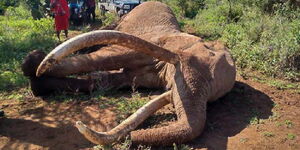Businessman Muchiri Gichuri has let the public in on his got-farming project that can deliver handsome returns, at times running into millions of shillings in revenue
While offering pieces of advice to prospective farmers, Gichuri noted that a farmer stood to earn Ksh2.7 million in a year just by selling one head of goat every day at a cost of Ksh7,500.
According to the businessman who had recently imported different breeds of goats, the animals are commonly reared for their meat, milk, manure and skin production.
“By selling a goat per week, we make Ksh7,500. For a month, that equals Ksh225,000 and in a year, that adds up to Ksh2.7 million,” he stated.
Gichuri noted that he was able to import his goats by taking a loan. In hindsight, he termed the move worthwhile because of the returns.
The Ministry of Agriculture and Livestock Development notes that the requirements for the importation of breeding goats in Kenya include a thorough examination for general disease control.
"On arrival, the animals and health certification documents shall be examined by officers of the Directorate of Veterinary Services at the port of entry.
"If the Director of Veterinary Services is not satisfied with the fulfilment of the requirements the animals may be ordered re-exported or destroyed at the expense of the importer," the ministry explains.
What Breed to Buy
According to Gichuri, there are different breeds of the animal and it is important to make a selection depending on the desired outcome.
Meat Production
Gichuri noted that the best breed for meat production was the Boer.
This is because it had a rapid weight gain of up to 100 kilograms over a short period of time. Also because of its good quality meat, it had a high demand and one would get good business.
Milk Production
The businessman stated that the best breed of goat to keep for milk production was the Saanen.
He explained that Saanen was the most productive in terms of milk giving up to 3 or 4 litres a day with an average milk yield of 838 Kg per 264 days of lactation.
“Goat milk is high in nutrients, lowers cholesterol levels, and is suitable for lactose-intolerant people,” he added.
At the same time, he noted that both the Boer and Saanen breed were good for breed improvement and could be crossed with other local breeds.
“For breed improvement, both breeds can be crossed with indigenous local breeds for increased productivity and well-adoptability. For reproduction, goats are fast-growing and breeding animals.
Maintenance and Management Tips
According to the businessman, a well-managed goat can breed twice a year, producing up to four kids who wean after four months.
To achieve this, he stated that the goat pen should be well maintained and cleaned as well as disease control and prevention measures considered.
"The goat pen should be clean and off-the-ground for easy droppings management for healthy and fast-growing goats.
"Goats must be dewormed every three months for disease control and prevention. Houses must be clean, provide adequate protection, and allow for adequate lighting and ventilation," he explained.
He noted that the goats should be fed well and given plenty of clean water. This also ensures fast growth and improved immunity which in turn leads to improved immunity.
For the purpose of making decisions in the future about the farm's required improvements, farmers should also keep records regarding production, age, health status, weight, feed and water, input costs, sales, and other pertinent data.












